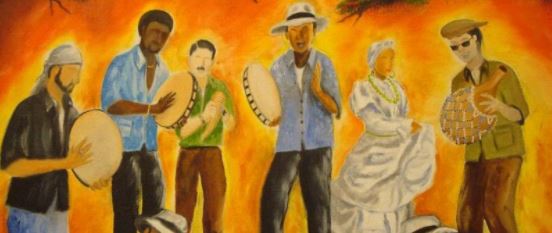This post is also available in:
 Español
Español
As this week Puerto Rico commemorates its “discovery” by Columbus (November 19) in 1493, our folk rhythm of “Plena” is still going strong over a century after its origin.
Note: this blog was originally published in 2010, when this rhythm celebrated its 105 anniversary.
Origins of Puerto Rican “Plena”
“La plena que yo te canto no es de la China ni del Japón;
porque la Plena viene de Ponce,
viene del barrio de San Antón”.
There’s a misconception that Bomba and Plena originated together. The fact is that Bomba originated much earlier, sometime in the mid-18th century, while we know that Plena was born in the early 19th century.
The exact origin of this Puerto Rican rhythm is hard to pinpoint, but most experts agree it was born around the year 1905 in the now non-existent slum of “La Joya del Castillo” (The Jewel of the Castle) in the city of Ponce.
Although this music was popularized in Ponce’s “Barrio San Antón“, it was in “La Joya del Castillo” where a couple immigrating from the Virgin Islands brought with them a “pandereta” (hand drum) and a guitar, with which they would play music with a rhythm and cadence that would excite the listeners and make them want to move to the beat of the music.
This rhythm would evolve to what eventually was called Plena, according to Felix Echevarría Alvarado, in his book titled “La Plena; Origen, Sentido, y Desarrollo en el Folklore Puertorriqueño”. This couple, which the locals nicknamed “los Ingleses” (The Englishmen), was formed by John Clark and Catherine George (a.k.a. Doña Catín).
Puerto Rican “Plena” Came From the Poor

Like so many other music genres, including American Jazz and Argentine Tango, this Puerto Rican rhythm was born in a very poor part of Ponce. Additionally, its formation and early songs expressed the experiences of those living around the “happy life” in a Puerto Rico slum. Songs like “Cortaron a Elena“, about a real incident that happened to a woman identified as Elena Sanchez, and “Ven Dale Ahora, Charlatán“, are examples of this type of experience.
By World War I (1917), it had become a popular form of music all around Puerto Rico, particularly in the coastal areas. The cities of Mayagüez and Loiza had such a strong adoption, that some had claimed the rhythm originated in these places.
Note: To learn more about the history of these rhythms, check our series “Renaissance of Bomba & Plena“.
Clip From Banco Popular’s “Raíces“
Banco Popular de Puerto Rico put together a great special on Bomba and Plena called “Raíces” (2001). Below I’m sharing a clip from that special, which highlights in just a few minutes the main aspects of Puerto Rican Plena. It details some information on its origins, how it’s conceived, and the instrumentation. In the second half of the clip, it transitions to talk about Bomba.


[…] For me, “aguinaldos”are associated with Christmas, and Christmas is associated with happiness and spirituality. That is if you can take aside the excessive gift commercialization that starts with Black Friday. Therefore, I find “aguinaldos” an enjoyable musical manifestation of our Latin Christmas tradition and culture. I also associate Christmas with the Puerto Rican folk genres of “Bomba” and “Plena”. For more on this, check out my blog on “plena” HERE). […]
[…] “Plena” is a happy rhythm that calls for celebration, which fits perfectly with the Christmas season. It is fairly easy to execute and lends itself to creating catchy song lyrics. The use of “plena“, therefore, enables a rich stream of new songs for “Navidad“. […]
[…] But before we get to that, let’s take a look at the icons of “Plena“. […]
[…] He founded the group that bears his nickname, choosing the difficult path of focusing their music on folkloric rhythms. Although this might not have been the best commercial decision, it certainly helped revive Puerto Rico’s folk rhythms of Bomba and Plena. […]
[…] Part 5, I’ll be covering the origins of Plena. As you’ll see, they’re very different than those of […]
[…] and Los Papines. The band slowly began emphasizing more the Afro-Puerto Rican rhythms of Bomba and Plena, two genres that emerged from the African diaspora in Puerto Rico. Bomba is a drum-based music that […]